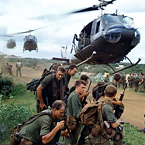SeaQueen
Posts: 1451
Joined: 4/14/2007
From: Washington D.C.
Status: offline

|
quote:
The Global Thunder MBX, a few years back, had an interesting example on ship steaming conditions:
Condition I: General quarters, all weapons and sensors manned, fatigue rate builds fairly quickly.
Condition II: relaxed GQ, personnel rest near battle stations, slower rate of fatigue accumulation.
Condition III: All sensors manned, some personnel near weapons stations, takes about 5 minutes to achieve full GQ status. Fatigue neutral.
Condition IV: Selected sensors manned, weapons typically unmanned, about 15 minutes to full GQ. Allows fatigue dissipation.
How would fatigue actually be quantified? How would the player manage "rotating watch shifts" in a surface (or land) group, so that at least some units are always on alert? Or should this be left completely to the AI? And how should this factor be communicated to the player?
Open to suggestions.
The problem with this, is that you're running dangerously close to modelling doctrine (badly), and not physical processes. In a real warship it actually gets far more nuanced than that, with specific readiness conditions tailored to specific scenarios. For example, they might have a "Condition IIIb" which might be optimized for transiting a minefield, and something else for an area with enhanced air breathing threats, still another for ballistic missile defense. Part of life on a warship is paying attention to the mostly irrelevant babblings on the intercom system (1MC) that regulate life. It even tells you when the sun rises, which for people in the CIC or engine room, might go unnoticed. And you're right, being at full general quarters probably isn't sustainable. At some point people need to do things like eat, shower, and sleep. The thing is, because there's so many different nuances in a ship's state of readiness, you probably wouldn't necessarily have to be at full general quarters in order to fight the ship effectively. So they ship's "readiness level" needn't actually correspond to a lowered level of readiness, depending on what the threat is. In that sense, I think it's a red herring.
The goal should not be to reproduce the HMS Sheffield, USS Stark, USS Vincennes, INS Hanit or USS Mason incidents. Each of those warships got struck because of a confluence of a unique set of circumstances, as the subsequent investigations revealed. There's also a ton of nuances to the rules of engagement that drove the Vincennes incident. Are you going to capture those too? If you've ever seen real rules of engagement, you'd realize that Command's duplication of that process is extremely crude. If we don't duplicate those exact circumstances, it isn't a failing of the simulation. The fact that these are famous incidents makes their significance loom large in the popular imagination, but there's also recent counter examples where the ship's defensive weapons performed very much as they do in Command game:
https://news.usni.org/2016/10/11/uss-mason-fired-3-missiles-to-defend-from-yemen-cruise-missiles-attack
Undefended warships get hit. Defended warships usually don't. This isn't a brilliant insight. I think much more insightful are the numbers from the Tanker Wars which suggest that generally speaking warships and vessels escorted by them tend to do quite well against cruise missile attacks, and undefended commercial vessels don't.
The truth is that ASCMs just aren't the best way to sink a ship. You're probably better off with a mine or torpedo. If you're going to try, its probably going to take a lot of missiles, a lot of planning, and several tries. Why should the game be changed if people who aren't very good players complain that they can't reproduce the Sheffield incident? If there was anything I'd change to make the game better, it's that the missile defense values are way low. They need to be at least tripled. If warships are in close formation, and they are benefiting from mutual support, the effectiveness is (literally) exponentially better, requiring even more weapons. That just has to do with the math of missile defense, and that's accurate. There's no need to change it.
I think it's a bad idea for Command to be trying to reproduce specific incidents and instead focus on the main underlying dynamics of the fight. Crew readiness (usually) isn't a driver.
< Message edited by SeaQueen -- 12/31/2020 1:59:07 PM >
|
 Printable Version
Printable Version










 on OODA and a holistic literature review on relationships with numerous theories, including Innovation Theory, Second Law of Thermodynamics, Gödel’s Incompleteness Theorem, Heisenberg’s Uncertainty or Inderminacy Principle and Boyd’s Integration Principle...
on OODA and a holistic literature review on relationships with numerous theories, including Innovation Theory, Second Law of Thermodynamics, Gödel’s Incompleteness Theorem, Heisenberg’s Uncertainty or Inderminacy Principle and Boyd’s Integration Principle... 

 New Messages
New Messages No New Messages
No New Messages Hot Topic w/ New Messages
Hot Topic w/ New Messages Hot Topic w/o New Messages
Hot Topic w/o New Messages Locked w/ New Messages
Locked w/ New Messages Locked w/o New Messages
Locked w/o New Messages Post New Thread
Post New Thread